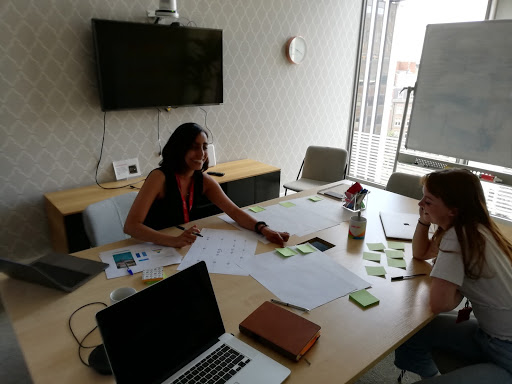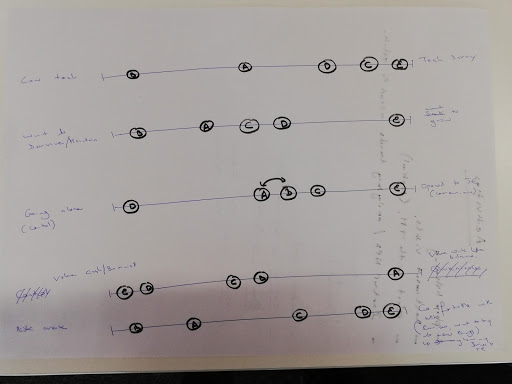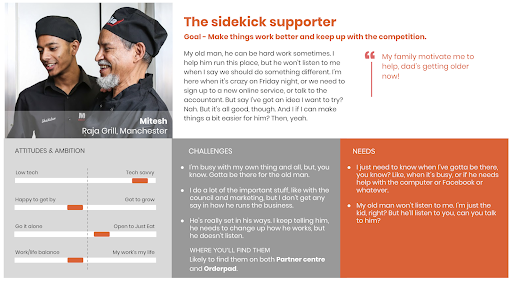When you think of Just Eat, you probably think of an app where you can order food right to your doorstep (maybe on a particularly hungover Sunday). You might think of the branding, the adverts, the food, the delivery driver at your door, and the experiences you’ve had. You might have ‘Did somebody say Just Eat’ stuck in your head (apologies if so). It’s unlikely you think of the actual restaurants you’ve ordered from, because using an app pus a distance between us as customers and the actual restaurant.
Behind the scenes and the experiences you have, there is a diverse range of restaurants that we need to understand and design for in the Restaurant team here at Just Eat. We were lacking a coherent story of our users, their behaviours and the challenges they face. We are super lucky that both UX designers and researchers are frequently encouraged to go out into the field and meet restaurant partners in their natural contexts. However, for those members of the wider business that don’t go out into the field, having artefacts that embody our Restaurant Partners needs is essential. And so, this project was born.
Archetypes and personas
Let’s start with the basics. What actually is an archetype? And is archetype just a fancy word for a persona? Well:
“A behavioural archetype conveys the “who does what, when they do it, & why” of our audience. Steeped in user behaviour, they focus on a group’s needs, motivations and pain-points, and capture how they think, feel and act in particular situations or scenarios.”
Personas, on the other hand, can be thought of as a hypothetical archetype of an actual user. They tend to include specific details such as age, sex, occupation, education and interests – which can’t be representative of all users. If you’d like to learn more, here’s an article that sums it up well.
For this situation, we chose to go with archetypes because of the credibility of having a behaviour based tool. We have a particularly large user base, so representing this with personas can be tricky. From a design perspective, understanding different behaviours helps us cater to them with our solutions. Also, because we are dealing with lots of different account managers and territory managers, archetypes help them to understand this is not one particular person but a way of aggregating our user types.
The value of archetypes
I briefly touched on how this project came about in the first paragraph, but it’s important to cover all the ways in which archetypes are an important tool for user centred design. The key points being;
- Build empathy for our Restaurant Partners throughout the business
- Help Product & Design teams make decisions with a shared picture of “the user” in mind
- Define the product roadmap and content strategy
- Sense check that solutions cater to all user types
- Understand when, where and how we can make a difference to our restaurant partners experiences
How

We tackled this project initially in a team of 3, later bringing in the help of our Principal Copywriter. We already had a set of archetypes in the design team for our restaurant partners, however the team didn’t identify with them and struggled to relate them back to their experiences with restaurant partners. So, our first step was to work with what we had and dissect them.
We gathered feedback on the current ones, and discussed in detail what information they contained, whether we felt it was relevant and whether we felt the archetypes in general were representative of our estate. What we found from feedback sessions was that the archetypes were hard to distinguish from one another, not particularly representative of our restaurant partners and their behaviours, lacked empathy and were generally not memorable. They included specific details that were hard to link to an archetype, for example, linking level of tech proficiency to success, which we know is not the case. There was also a lack of trust from the team and Territory managers. Involving them in the process and engaging everyone would lead to more trustworthy and robust archetypes, as well as get buy in and increase the likelihood of people using them.
Evolution through talking to our Restaurant Partners
Between the team, we observed many usability sessions in our research lab with the archetypes in front of us to identify gaps and opportunities. We then decided to formulate a set of ‘profiling questions’ informed based on previous rounds of research to ask every single restaurant partner we spoke to. This would allow us to draw out key differences between our user base. We asked our Restaurant Partner’s a series of questions;
- What motivates you to wake up every day in the morning to go to your restaurant?
- Where would you like your restaurant to be in 3–5 years?
- What does a day-to-day look like?
- What keeps you awake at night? What are your biggest everyday challenges?
As part of this project alone, we spoke to over 50 restaurant partners from a mix of backgrounds; a range of Partner Status’, cuisines and locations both in the lab and out in the field. While we gained insight from asking questions, we also gained a lot from observation. In addition to this, we spent three hours listening in to calls in the call centre.
The process we took as a team was very agile — meeting frequently and building up a picture as we went along, whilst iterating along the way. As we gained richer insight, we were able to start thinking about what information we’d actually include on the archetypes for them to be a valuable design tool.

We came up with the idea of a behaviour trait spectrum, to help us distinguish the archetypes from one another. This was heavily informed by behaviours and attitudes we’d both observed and heard expressed by our restaurant partners. For example – ‘Happy to get by’ versus ‘Got to grow’, highlighting the difference between Restaurant Partners who are more reactive and focused on day to day operations in contrast to ones who are more proactive, focused on long term strategy and growth. Once we’d identified the different attitudes, we mapped our drafted archetypes to the scales.

Validating
Cumulatively, the design team has a tonne of experience and insight into our restaurant partners both out in the field and in the usability labs, so testing out the archetypes with them was essential.
The other group crucial to validating these archetypes is Account Managers and Territory Managers. Their role involves speaking to Restaurant Partners all day everyday, and they are out there on the front line hearing their challenges and stories. We conducted a workshop with members from this group to gain further insight into our archetypes, their relatability and % of our estate.
During these workshops, we were hoping to hear things like; ‘Oh yes this restaurant partner I visited is definitely that one’, to validate that our archetypes were relatable. We also wanted to check if they felt there were any gaps. We asked for stories or quotes around certain archetypes, to add to their realness and build further empathy. Territory and Account managers were able to relate to the new archetypes and give further suggestions, as well as insight into how much of our estate they think they account for. Our Principal Copywriter Mike was able to re-write the archetypes in a compelling way, using first person to help us feel connected to them.
New archetypes

The new archetypes are framed in a way that makes it easy to step into the restaurant’s shoes easily — particularly through the use of first person and real life quotes.
Clearly defining the challenges and needs allows us to understand what the restaurant partner needs from our products and their motivations behind it. We understand their pain points, meaning we can check our solutions to ensure we’re helping them overcome those.
Together, the challenges, needs and attitudes and ambition matrix as well as ‘Where you’ll find them’ builds up a picture of our entire product ecosystem. We can gauge their motivations and behaviours around the products we design.
Result
- Greater empathy in the Restaurant pillar: The design team now has referenceable archetypes that are widely used in sprint kick offs and playbacks with teams to build empathy for our restaurant partners and consider different types of restaurants & scenarios that we need to cater to with our designs.
- Widely shared: Further, the archetypes have been presented on numerous occasions at company and pillar wide meetings and global design all hands, as well as product huddles. They are used outside of the design team to educate stakeholders and build a picture of the estate we design for.
- Helpful as a training material and resource: They’ve also proved useful for Territory Managers and Account Managers in carrying out their roles;
“Really interesting stuff you’re working on. It’s been needed for so long” — Market Activation Manager — Collection • Sales, Customer Marketing
- User friendly design solutions: From the early ideation phase, archetypes are used by the design team to ensure each solution fits the needs of all user types
Next steps
Having distributed the Marketplace Restaurant archetypes, we’ll keep sense checking these and evolving them. We’re using these archetypes and the process we took to pave the way for our Canadian team at Skip the Dishes to do the same.
The next big thing is Branded Restaurant Group (the chain restaurants that you know and love) archetypes. We identified that Branded restaurants have different roles, behaviours and needs and therefore don’t fit in to the archetypes detailed above. The team worked closely with the strategic account managers to formulate initial archetypes, and delivered a first draft of these archetypes in December.
Watch this space for more archetype updates!